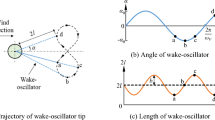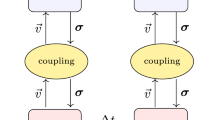Abstract
This paper investigates the unsteady aerodynamic characteristics of an oscillating flat plate and the NACA 0012 airfoil around the angle of attack (AoA) close to their static stall angle at a low Reynolds number, 3.2 × 104. The kinematic oscillatory motion is described by a sinusoidal function in which the oscillation frequency and amplitude are variable. Both experimental and numerical methods are applied in the two-dimensional space. The experiment aims at measuring the aerodynamic forces and the moment directly. For numerical simulation, the SST (Shear Stress Transport) gamma theta model is employed to solve the unsteady flow field and to compute the lift coefficients (CLs). Good qualitative agreement between the experimental and numerical results for CL is obtained, which demonstrates the feasibility of the modified RANS model in the flow transition case. In general, NACA 0012 is greatly influenced by the dynamic effect in contrast with the flat plate. For a given reduced frequency, the shape of the hysteresis loop of CL shows some distinguishing features; the process of flow reattachment of NACA 0012 is slower than that of the flat plate in the downstroke phase, so that a smooth transition of CL is observed; there are still vortices shedding from the trailing edge even at small angles of attack, which results in a local instability of CL. By studying the effects of the reduced frequency (K) and the amplitude, it is found that the AoA corresponding to the maximum CL is more sensitive to the former and the reduced pitch rate (a') is the main parameter determining the dynamic stall angle for both flat plate and NACA 0012. In addition, the results for K = 0.07 show that the lift and drag coefficients at a maximum angle of attack are close to their static values for the discussed amplitudes and wing geometries.
Similar content being viewed by others
Abbreviations
- a :
-
pivot point
- c :
-
chord, m.
- K :
-
reduced frequency, ωc/2U.
- U :
-
mean wind tunnel velocity, ms−1
- s :
-
span of the wing geometry, m
- t :
-
blade thickness, m
- α:
-
angle of attack, deg
- ά:
-
reduced pitch rate, deg
- α0 :
-
mean angle of attack, deg
- α1 :
-
oscillation amplitude, deg
- αmax :
-
maximum angle of attack, deg
- αmaxCL :
-
angle of attack corresponding to the maximum lift coefficient
- ω :
-
oscillation frequency, Hz
- t :
-
physical time, s
- τ:
-
dimensionless time, tc/2U.
- AoA:
-
angle of attack, deg
- AR:
-
aspect ratio
- CL:
-
aerodynamic lift coefficient
- CD:
-
aerodynamic drag coefficient
- CM:
-
aerodynamic moment coefficient
- LEV:
-
leading-edge vortex
- Re:
-
Reynolds number
References
G.B. McCullough and D.E. Gault, “Examples of three representative types of airfoil-section stall at low speed,” NASA Technical Note 2502 (1951).
J.W. Ward, “The behaviour and effects of laminar separation bubbles on aerofoils in incompressible flow,” J. Aeronaut. Sci. 67 (636), 783–790 (1963).
P. Crimi and B. Reeves, “A method for analyzing dynamic stall,” 10th Aerospace Sciences Meeting, p. 37 (1972).
W.J. McCroskey, “The phenomenon of dynamic stall,” NASA Tech. Memo. 81264 (1981).
W.J. McCroskey, L.W. Carr, and K.W. McAlister, “Dynamic stall experiments on oscillating airfoils,” AIAA J. 14 (1), 57–63 (1976).
K.W. McAlister, L.W. Carr, and W.J. McCroskey, “Dynamic stall experiments on the NACA 0012 airfoil,” NASA Technical Paper 1100 (1978).
P. Wernert, W. Geissler, M. Raffel, and J. Kompenhans, “Experimental and numerical investigations of dynamic stall on a pitching airfoil,” AIAA J. 34 (5), 982–989 (1996).
A.B. Linn, “Determination of average lift of a rapidly pitching airfoil,” Worcester Polytechnic Institute (1999).
P. Gerontakos, “An experimental investigation of flow over an oscillating airfoil,” Dissertation, McGill University (2004).
A. Krzysiak, “Experimental investigation of a dynamic stall on the oscillating NACA 0012 airfoil,” Prace Instytutu Lotnictwa, 1–52 (2006).
C.P. Ellington, C. Van Den Berg, A.P. Willmott, and A.L.R. Thomas, “Leading-edge vortices in insect flight,” Nature, 384 (6610), 626 (1996).
D.J. Pines and F. Bohorquez, “Challenges facing future micro-air-vehicle development,” J. Aircraft 43(2), 290–305 (2006).
M.F. Platzer, K.D. Jones, J. Young, and J. C.S. Lai, “Flapping wing aerodynamics: progress and challenges,” AIAA J. 46 (9), 2136–2149 (2008).
M. Okamoto and A. Azuma, “Aerodynamic characteristics at low Reynolds number for wings of various plan-forms,” AIAA J. 49 (6), 1135–1150 (2011).
W. Shyy, H. Aono, C. Kang, and H. Liu, An Introduction to Flapping Wing Aerodynamics (Univ. Press, Cambridge, 2013).
M. Mizoguchi and H. Itoh, “Effect of aspect ratio on aerodynamic characteristics of rectangular wings at low Reynolds numbers,” 50th AIAA Aerospace Sciences Meeting including the New Horizons Forum and Aerospace Exposition, 2012, p. 52.
D.H. Kim and J.W. Chang, “Unsteady boundary layer for a pitching airfoil at low Reynolds numbers,” J. Mech. Sci. Technol. 24 (1), 429–440 (2010).
D.H. Kim and J.W. Chang, “Low-Reynolds-number effect on the aerodynamic characteristics of a pitching NACA 0012 airfoil,” Aerospace Sci. Technol. 32 (1), 162–168 (2014).
A. Naderi, M. Mojtahedpoor, and A. Beiki, “Numerical investigation of non-stationary parameters on effective phenomena of a pitching airfoil at low Reynolds number,” J. Appl. Fluid Mech. 9, 2 (2016).
G. Bangga and H. Sasongko, “Dynamic stall prediction of a pitching airfoil using an adjusted two-equation URANS turbulence model,” J. Appl. Fluid Mech. 10 (1), 1–10 (2017).
Y. Yu, X. Amandolese, C. Fan, and Y Liu, “Experimental study and modelling of unsteady aerodynamic forces and moment on flat plate in high amplitude pitch ramp motion,” J. Fluid Mech. 846, 82–120 (2018).
F.R. Menter, R.B. Langtry, S.R. Likki, Y.B. Suzen, P.G. Huang, and S. Völker, “A correlation-based transition model using local variables—part I: Model formulation,” J. Turbomach. 128 (3), 413–422 (2006).
R.B. Langtry, F.R. Menter, S.R. Likki, Y.B. Suzen, P.G. Huang, and S. Völker, “A correlation-based transition model using local variables—part II: Test cases and industrial applications,” J. Turbomach. 128 (3), 423–434 (2006).
S. Roy, Z. Huque, K. Lee, and R. Kommalapati, “Turbulence model prediction capability in 2D airfoil of NREL wind turbine blade at stall and post stall region,” J. Clean Energy Technol. 5 (6) (2017).
D. Poirel, Y. Harris, and A. Benaissa, “Self-sustained aeroelastic oscillations of a NACA 0012 airfoil at low-to-moderate Reynolds numbers,” J. Fluids Structures 24 (5), 700–719 (2008).
Acknowledments
The first author thanks Prof. Xavier Amandolese for his guidance on unsteady aerodynamics during the internship in France.
Author information
Authors and Affiliations
Corresponding author
Additional information
Declaration of Conflicting Interests
The Authors declare no potential conflicts of interest with respect to the research, authorship, and/or publication of this article.
Russian Text © The Author(s), 2019, published in Izvestiya RAN. Mekhanika Zhidkosti i Gaza, 2019, No. 5, pp. 102–116.
Rights and permissions
About this article
Cite this article
Fan, C., Wu, Y., Yu, Y. et al. Dynamic Thin-Airfoil Stall and Leading-Edge Stall of Oscillating Wings at Low Reynolds Number. Fluid Dyn 54, 691–704 (2019). https://doi.org/10.1134/S0015462819040128
Received:
Revised:
Accepted:
Published:
Issue Date:
DOI: https://doi.org/10.1134/S0015462819040128




